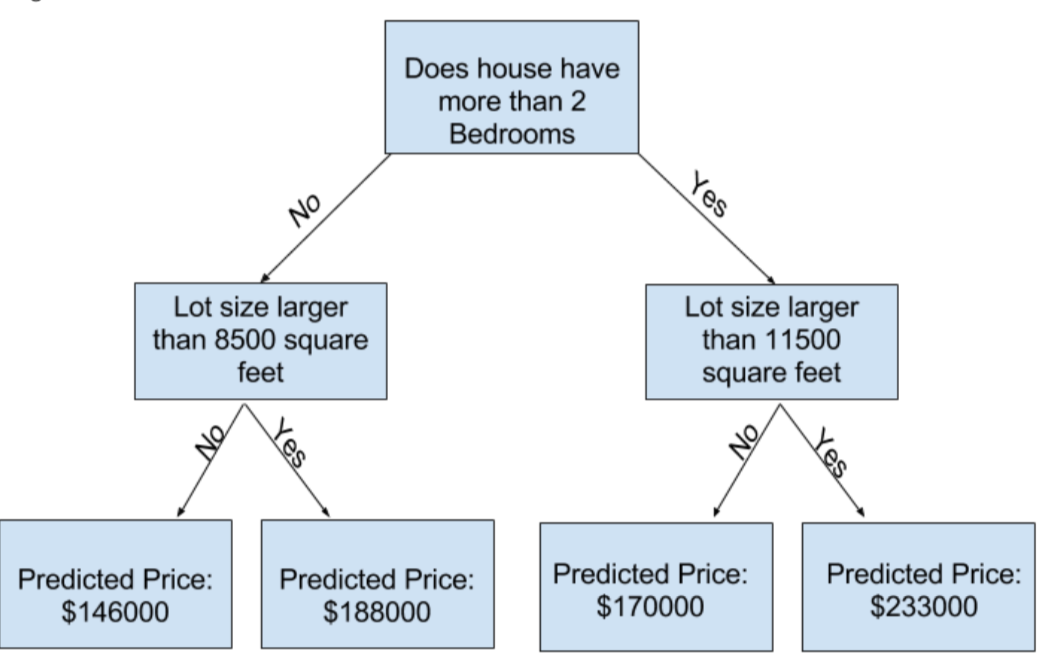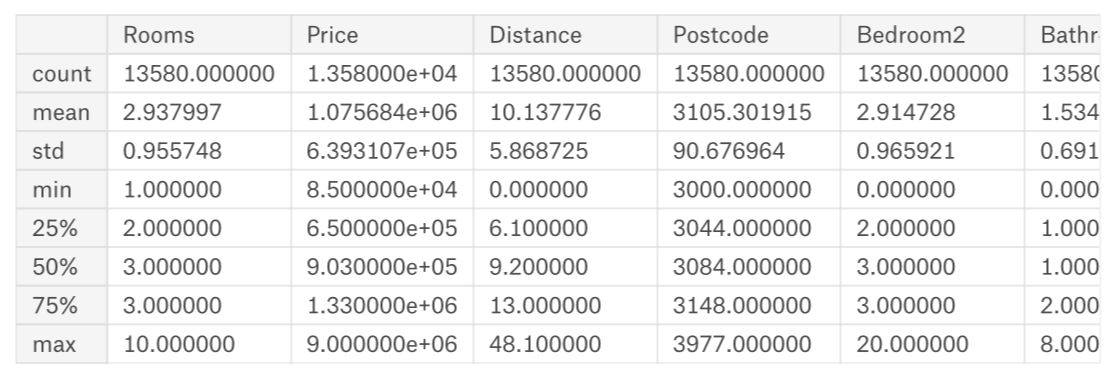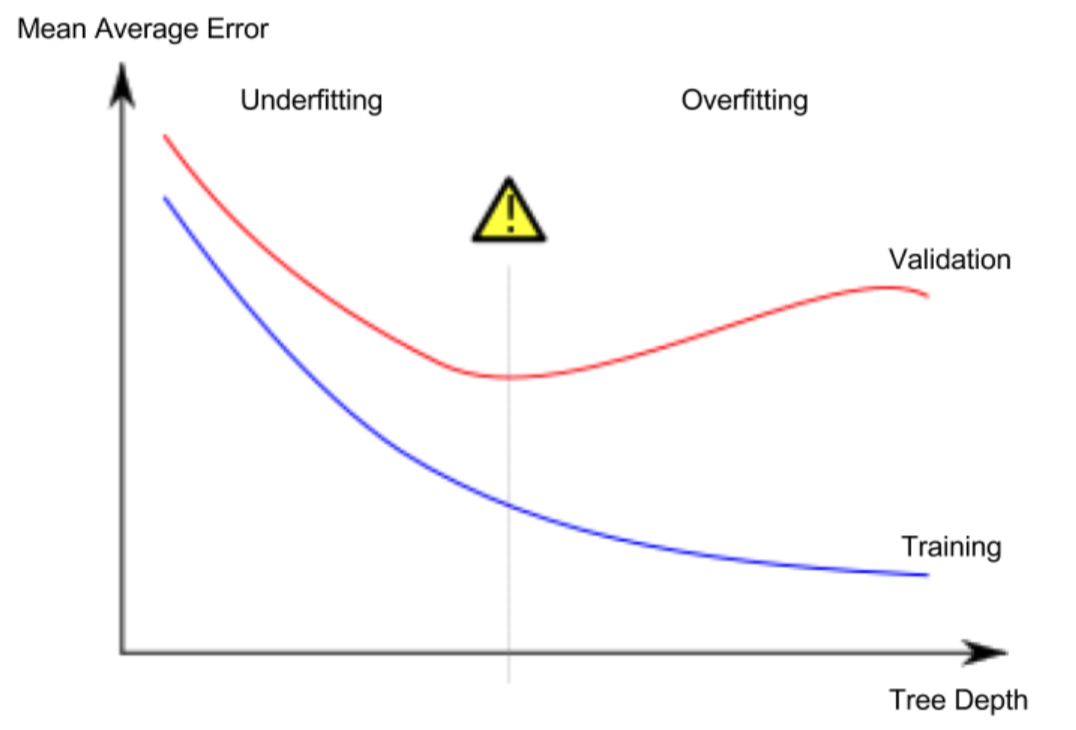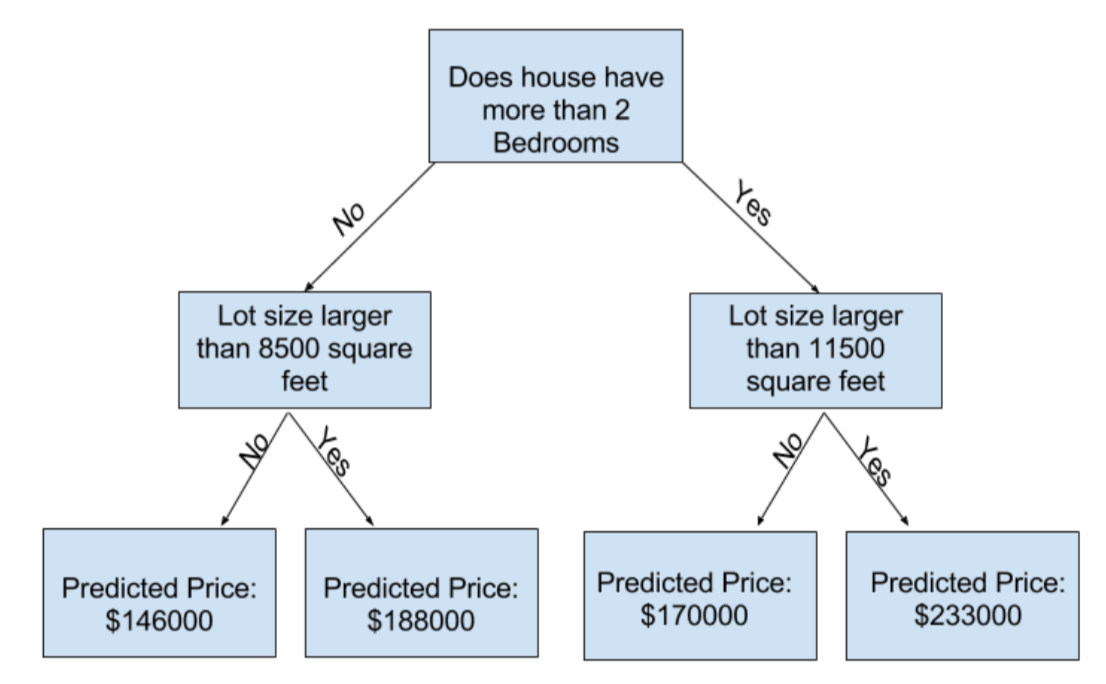Intro to Machine Learning
本节主要用于机器学习入门,介绍两个简单的分类模型:
决策树和随机森林
不涉及内部原理,仅仅介绍基础的调用方法
1. How Models Work
以简单的决策树为例
This step of capturing patterns from data is called fitting or training the model
The data used to train the data is called the trainning data
After the model has been fit, you can apply it to new data to predict prices of additional homes

2.Basic Data Exploration
使用pandas中的describle()来探究数据:
melbourne_file_path = '../input/melbourne-housing-snapshot/melb_data.csv'
melbourne_data = pd.read_csv(melbourne_file_path)
melbourne.describe()
output:

注:数值含义
count: 非缺失值的数量
mean: 平均值
std: 标准偏差,它度量值在数值上的分布情况
min、25%、50%、75%、max: 将每一列按照从lowest到highest排序,最小值是min, 1/4位置上,大于25%而小于50%是25%
3.Your First Machine Learning Model
- Selecting Data for Modeling
import pandas as pd
melbourne_file_path = ' ../input/melbourne-housing-snapshot/melb_data.csv'
melbourne_data = pd.read_csv(melbourne_file_path)
- Selecting The Prediction Target
方法:使用dot-notation来挑选prediction target
- Choosing "Features"
melbourne_features = ['Rooms', 'Bathroom', 'Landsize', 'Lattitude', 'Longtitude']
X = melbourne_data[melbourne_features]
查看数据是否加载正确:
X.head()
探究数据基本特性:
- Building Your Model
我们使用scikit-learn来创造模型,scikit-learn教程如下:
具体的原理可以根据需要自己探究
https://scikit-learn.org/stable/supervised_learning.html#supervised-learning
构建模型步骤:
- Define:
What type of model will it be? A decision tree? Some other type of model? Some other parameters of the model type are specified too.
- Fit:
Capture patterns from provided data. This is the heart of modeling
- Predict:
Just what it sounds like
- Evaluate:
Determine how accurate the model's predictions are
实现:
from sklearn.tree import DecisionTreeRegressor
melbourne_mode = DecisionTreeRegressor(random_state=1)
melbourne_mode.fit(X , y)
打印出开始几行:
print (X.head())
预测后的价格如下:
print (melbourne_mode.predict(X.head())
4.Model Validation
由于预测的价格和真实的价格会有差距,而差距多少,我们需要衡量
使用Mean Absolute Error
error= actual-predicted
在实际过程中,我们要将数据分成两份,一份用于训练,叫做training data, 一份用于验证叫validataion data
from sklearn.model_selection import train_test_split
train_X, val_X, train_y, val_y = train_test_split(X, y, random_state=0)
melbourne_model = DecisionTreeRegressor()
melbourne_model.fit(train_X, train_y)
val_predictions = melbourne_model.predict(val_X)
print(mean_absolute_error(val_y, val_predictions))
5.Underfitting and Overfitting
- overfitting: A model matches the data almost perfectly, but does poorly in validation and other new data.
- underfitting: When a model fails to capture important distinctions and patterns in the data, so it performs poorly even in training data.

The more leaves we allow the model to make, the more we move from the underfitting area in the above graph to overfitting area.

from sklearn.metrics import mean_absolute_error
from sklearn.tree import DecsionTreeRegressor
def get_ame(max_leaf_nodes, train_X, val_X, train_y, val_y):
model = DecisionTreeRegressor(max_leaf_nodes = max_leaf_nodes, random_state = 0)
model.fit(train_X, train_y)
preds_val = model.predict(val_X)
mae = mean_absolute_error(val_y, preds_val)
return(mae)
我可以使用循环比较选择最合适的max_leaf_nodes
for max_leaf_nodes in [5,50,500,5000]:
my_ame = get_ame(max_leaf_nodes, train_X, val_X, train_y, val_y)
print(max_leaf_nodes, my_ame)

最后可以发现,当max leaf nodes 为 500时,MAE最小, 接下来我们换另外一种模型
6.Random Forests
The random forest uses many trees, and it makes a prediction by averaging the predictions of each component tree. It generally has much better predictive accuracy than a single decision tree and it works well with default parameters.
from sklearn.ensemble import RandomForestRegressor
from sklearn.metrics import mean_absolute_error
forest_model = RandomForestRegressor(random_state=1)
forest_model.fit(train_X,train_y)
melb_preds = forest_model.predict(val_X)
print(mean_absolute_error(val_y, melb_preds))
可以发现最后的误差,相对于决策树小。
one of the best features of Random Forest models is that they generally work reasonably even without this tuning.

7.Machine Learning Competitions
- Build a Random Forest model with all of your data
- Read in the "test" data, which doesn't include values for the target. Predict home values in the test data with your Random Forest model.
- Submit those predictions to the competition and see your score.
- Optionally, come back to see if you can improve your model by adding features or changing your model. Then you can resubmit to see how that stacks up on the competition leaderboard.
Intro to Machine Learning的更多相关文章
- 【机器学习Machine Learning】资料大全
昨天总结了深度学习的资料,今天把机器学习的资料也总结一下(友情提示:有些网站需要"科学上网"^_^) 推荐几本好书: 1.Pattern Recognition and Machi ...
- 机器学习(Machine Learning)&深度学习(Deep Learning)资料【转】
转自:机器学习(Machine Learning)&深度学习(Deep Learning)资料 <Brief History of Machine Learning> 介绍:这是一 ...
- How do I learn machine learning?
https://www.quora.com/How-do-I-learn-machine-learning-1?redirected_qid=6578644 How Can I Learn X? ...
- 机器学习(Machine Learning)与深度学习(Deep Learning)资料汇总
<Brief History of Machine Learning> 介绍:这是一篇介绍机器学习历史的文章,介绍很全面,从感知机.神经网络.决策树.SVM.Adaboost到随机森林.D ...
- Easy machine learning pipelines with pipelearner: intro and call for contributors
@drsimonj here to introduce pipelearner – a package I'm developing to make it easy to create machine ...
- How do I learn mathematics for machine learning?
https://www.quora.com/How-do-I-learn-mathematics-for-machine-learning How do I learn mathematics f ...
- 机器学习案例学习【每周一例】之 Titanic: Machine Learning from Disaster
下面一文章就总结几点关键: 1.要学会观察,尤其是输入数据的特征提取时,看各输入数据和输出的关系,用绘图看! 2.训练后,看测试数据和训练数据误差,确定是否过拟合还是欠拟合: 3.欠拟合的话,说明模 ...
- 【Machine Learning】KNN算法虹膜图片识别
K-近邻算法虹膜图片识别实战 作者:白宁超 2017年1月3日18:26:33 摘要:随着机器学习和深度学习的热潮,各种图书层出不穷.然而多数是基础理论知识介绍,缺乏实现的深入理解.本系列文章是作者结 ...
- 【Machine Learning】Python开发工具:Anaconda+Sublime
Python开发工具:Anaconda+Sublime 作者:白宁超 2016年12月23日21:24:51 摘要:随着机器学习和深度学习的热潮,各种图书层出不穷.然而多数是基础理论知识介绍,缺乏实现 ...
随机推荐
- scrapy框架与python爬虫
- python开发基础--思维导图
开始学习python,相当于零基础 非自学,自学的痛苦不想体会和尝试,毕竟不会很友好,知乎上看到很多说自学的好处啊噼里啪啦的.嗯,说的很对,但是我偏不听,略略略.锻炼我的自学能力,这还需要锻炼吗,百度 ...
- ASP.NET CORE系列【七】分析NetCore启动原理
前言 有很久一段时间没更新了,因为工作和家里的问题导致没能坚持, 现在开始会继续每周更新,主要是记录自己所学和一起讨论解决过的问题,一起成长, 为.net圈子添砖加瓦! 介绍 到目前为止应该很多同学已 ...
- java学习-NIO(二)Buffer
当我们需要与 NIO Channel 进行交互时, 我们就需要使用到 NIO Buffer, 即数据从 Buffer读取到 Channel 中, 并且从 Channel 中写入到 Buffer 中.缓 ...
- Ant Design Pro 脚手架+umiJS 实践总结
一.简介 1.Ant Design Pro Ant Design Pro是一款搭建中后台管理控制台的脚手架 ,基于React,dva.js,Ant Design (1)其中dva主要是控制数据流向,是 ...
- DT-06 For MQTT
感谢关注深圳四博智联科技有限公司产品!我公司提供完整的WiFi信号强度采集方案,包括WiFi信号采集.设备远程管理平台.智能终端应用等. Doit_MQTT透传固件基于乐鑫ESP_IOT_SDK使用C ...
- 浅谈IDEA搭建SSM框架的集成
前言 学习完MyBatis,Spring,SpringMVC之后,我们需要做的就是将这三者联系起来,Spring实现业务对象管理,Spring MVC负责请求的转发和视图管理, MyBatis作为数据 ...
- (17)ASP.NET Core EF基于数据模型创建数据库
1.简介 使用Entity Framework Core构建执行基本数据访问的ASP.NET Core MVC应用程序.使用迁移(Migrations)基于数据模型创建数据库,你可以在Windows上 ...
- 定时清理docker私服镜像
定时清理docker私服镜像 使用CI构建docker镜像进行发布极大促进了大家的版本发布效率,于是镜像仓库也就急速膨胀.为了缓解磁盘压力,我们需要设置一些清理策略. 对于不同docker镜像的清理策 ...
- 使用executor、callable以及一个Future 计算欧拉数e
package test; import java.math.BigDecimal; import java.math.MathContext; import java.math.RoundingMo ...
